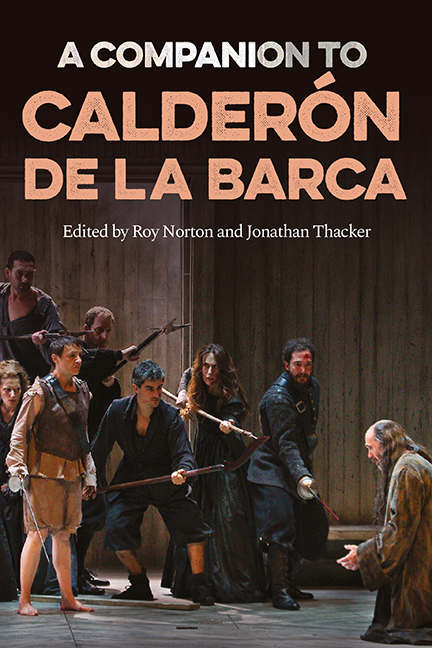Book contents
- Frontmatter
- Dedication
- Contents
- List of Illustrations
- List of Contributors
- Acknowledgements
- List of Abbreviations
- Introduction
- 1 Biography and Context
- 2 The Calderonian World
- 3 The Playwright’s Craft: Calderón and the Great Theatrical World of Early Modern Spain
- 4 La vida es sueño
- 5 The Honour Plays of Calderón
- 6 Calderón, the Comedian
- 7 Mythological Court Spectacle Plays
- 8 Religious comedias
- 9 Calderón’s ‘Sacramental, Allegorical and Historical’ autos
- 10 Calderón’s graciosos
- 11 Calderón and Visual Art
- 12 The Staging of Calderón’s Theatre
- 13 Calderón’s European Reception from Romanticism to the Twentieth Century
- 14 The Reception of Calderón in the Hispanic World
- Appendices
- Consolidated Bibliography
- Index
- Tamesis • Companions
12 - The Staging of Calderón’s Theatre
Published online by Cambridge University Press: 07 October 2022
- Frontmatter
- Dedication
- Contents
- List of Illustrations
- List of Contributors
- Acknowledgements
- List of Abbreviations
- Introduction
- 1 Biography and Context
- 2 The Calderonian World
- 3 The Playwright’s Craft: Calderón and the Great Theatrical World of Early Modern Spain
- 4 La vida es sueño
- 5 The Honour Plays of Calderón
- 6 Calderón, the Comedian
- 7 Mythological Court Spectacle Plays
- 8 Religious comedias
- 9 Calderón’s ‘Sacramental, Allegorical and Historical’ autos
- 10 Calderón’s graciosos
- 11 Calderón and Visual Art
- 12 The Staging of Calderón’s Theatre
- 13 Calderón’s European Reception from Romanticism to the Twentieth Century
- 14 The Reception of Calderón in the Hispanic World
- Appendices
- Consolidated Bibliography
- Index
- Tamesis • Companions
Summary
Bringing a play-text to life means having to make decisions related to many different areas of staging: special effects, music, casting, costume and set design, amongst other myriad elements of the performance. In this chapter we shall focus on specific aspects of this scenography, relying on evidence taken both from indications left by the dramatist in the play-texts themselves and from other related documents that explain the use of materials or strategies for performance.
Long neglected by scholars, who largely saw theatre as dramatic poetry whose essence was to be found in the text, scenography has more recently been accorded a greater importance, justified by the pre-eminence of the visual in contemporary culture, an importance that risks, it must be said, the opposite bias, exaggerating the significance of staging in the analysis of theatrical works. The road to the rediscovery of the important role of scenography was laid out in the twentieth century by three scholars in particular – Shergold, Varey and Ruano – who have provided, with the help of some others, an indispensable history de-tailing the richness of the staging of Spanish Golden Age theatre, including that of Calderón de la Barca.
Studying staging in Calderón necessitates an explanation of Spanish Golden Age drama in the round since, within each genre and each dramatic mode, Calderón exhibits an exceptional command of scenography. In fact, his position as a universally recognised figure in the world of drama is based in part on his mastery of the mise-en-scène.
THE EVIDENCE FOR CALDERÓN AS A SCENOGRAPHER
Staging is integral to theatre and Calderón is a man of the theatre. The richness and variety of his engagement with this aspect of playwriting is illustrated by what he does differently in relation to genre, space, theme or the particularity of each work. We find in Calderón all the rich variety of staging associated with the distinct genres and circumstances of composition and performance, from the limited exploitation of resources in the cloak and sword comedies, written for the corrales [playhouses], to the most spectacular of stage effects contained in the auto sacramental [Corpus Christi play] or in the mythological palace plays.
- Type
- Chapter
- Information
- A Companion to Calderón de la Barca , pp. 250 - 283Publisher: Boydell & BrewerPrint publication year: 2021



